7 Reasons Why Jiuzhaigou Valley Should Be on Your Travel Bucket List
An Essential Guide to Visiting Jiuzhaigou Valley
Nestled in the heart of Sichuan province, Jiuzhaigou Valley is a breathtaking natural wonder that feels like a scene pulled straight from a fairy tale. Renowned for its stunningly vibrant lakes, cascading waterfalls, and lush, colorful forests, this UNESCO World Heritage site captivates the eyes and hearts of all who visit. What sets Jiuzhaigou apart is its kaleidoscopic lakes, often reflecting an array of colors that change with the seasons, creating a mesmerizing display of nature’s artistry.
In this essential guide, we will navigate through the enchanting landscapes of Jiuzhaigou Valley, highlighting the must-see spots such as the iconic Five Flower Lake and the breathtaking Pearl Shoal Waterfall. You’ll find practical information on how to get there, the best times to visit, accommodation tips, and insights on avoiding altitude sickness. Whether you’re a nature enthusiast, a photography lover, or simply seeking tranquility, this guide will ensure you make the most of your journey through this surreal paradise. Prepare to be awed by the beauty of Jiuzhaigou Valley as we embark on an unforgettable adventure!
In This Guide
- An Essential Guide to Visiting Jiuzhaigou Valley
- The Rich History and Legends of Jiuzhaigou Valley
- Main Highlights: What You Absolutely Can’t Miss
- Planning Your Visit: A Practical Guide
- Tickets: Prices, Booking, and Tips
- How to Get There: A Complete Transportation Guide
- Local Cuisine and Accommodation Nearby
- Frequently Asked Questions
- Final Thoughts on Your Trip
The Rich History and Legends of Jiuzhaigou Valley
Jiuzhaigou Valley, a breathtaking UNESCO World Heritage Site in China’s Sichuan Province, is not only celebrated for its stunning natural beauty but also for its rich tapestry of history and legends that envelop the region. This Y-shaped valley, whose name translates to “Nine Village Valley,” is steeped in cultural significance and folklore that adds depth to its picturesque landscapes.
Ancient Roots: The Tibetan Influence
The history of Jiuzhaigou can be traced back over 2,000 years, with the region originally inhabited by Tibetan tribes. These early settlers established the nine villages that give the valley its name. The Tibetan culture is deeply embedded in Jiuzhaigou, where visitors can still find traditional architectural styles and customs. The harmonious relationship between the local Tibetan people and their natural surroundings is evident in their practices, festivals, and spiritual beliefs, which revolve around the stunning beauty of the landscape.
The Legend of the Valley’s Creation
One of the most enchanting legends associated with Jiuzhaigou is that of the valley’s formation. According to local folklore, the valley was once home to a beautiful goddess who fell in love with a mortal man. Their love was forbidden, leading to a series of tragic events. To express her grief, the goddess wept, and her tears formed the sparkling lakes that now dot the valley. The vibrant colors of the lakes symbolize her unending love, while the waterfalls represent her sorrow as they cascade down the cliffs.
A Historical Sanctuary
Throughout history, Jiuzhaigou has served as a sanctuary for wildlife and a refuge for various ethnic communities. By the 1950s, the area was designated as a nature reserve to protect its unique ecosystems. This move was pivotal in preserving the natural beauty and biodiversity of the region, allowing it to thrive as a protected area. The valley was eventually opened to tourism in the 1980s, drawing visitors from around the globe to experience its magnificent landscapes and rich cultural heritage.
The Cultural Heritage of the Tibetan Villages
The nine Tibetan villages within Jiuzhaigou are not just remnants of the past; they are living communities where ancient traditions continue to thrive. Visitors can witness Tibetan festivals, sample traditional foods, and explore handicrafts made by local artisans. The vibrant prayer flags fluttering in the breeze are a testament to the spiritual connection the villagers maintain with their environment. This cultural richness provides an immersive experience, allowing travelers to appreciate not only the natural beauty but also the deep-rooted history that shapes Jiuzhaigou.
Modern Recognition and Preservation
In 1992, Jiuzhaigou was designated as a UNESCO World Heritage Site, further solidifying its status as one of the world’s most precious natural wonders. This recognition has led to increased efforts in conservation and sustainable tourism practices, ensuring that the valley’s delicate ecosystems and rich cultural heritage are preserved for future generations.
The Legends that Linger
As you wander through the stunning landscapes of Jiuzhaigou, it’s impossible not to feel the weight of its history and the whispers of legends that linger in the air. Each lake, waterfall, and forest holds a story, inviting visitors to connect with the myths and realities that have shaped this extraordinary valley. Whether it’s the tale of the sorrowful goddess or the enduring spirit of the Tibetan villagers, Jiuzhaigou is a place where history and legend intertwine, creating a truly magical experience for all who visit.
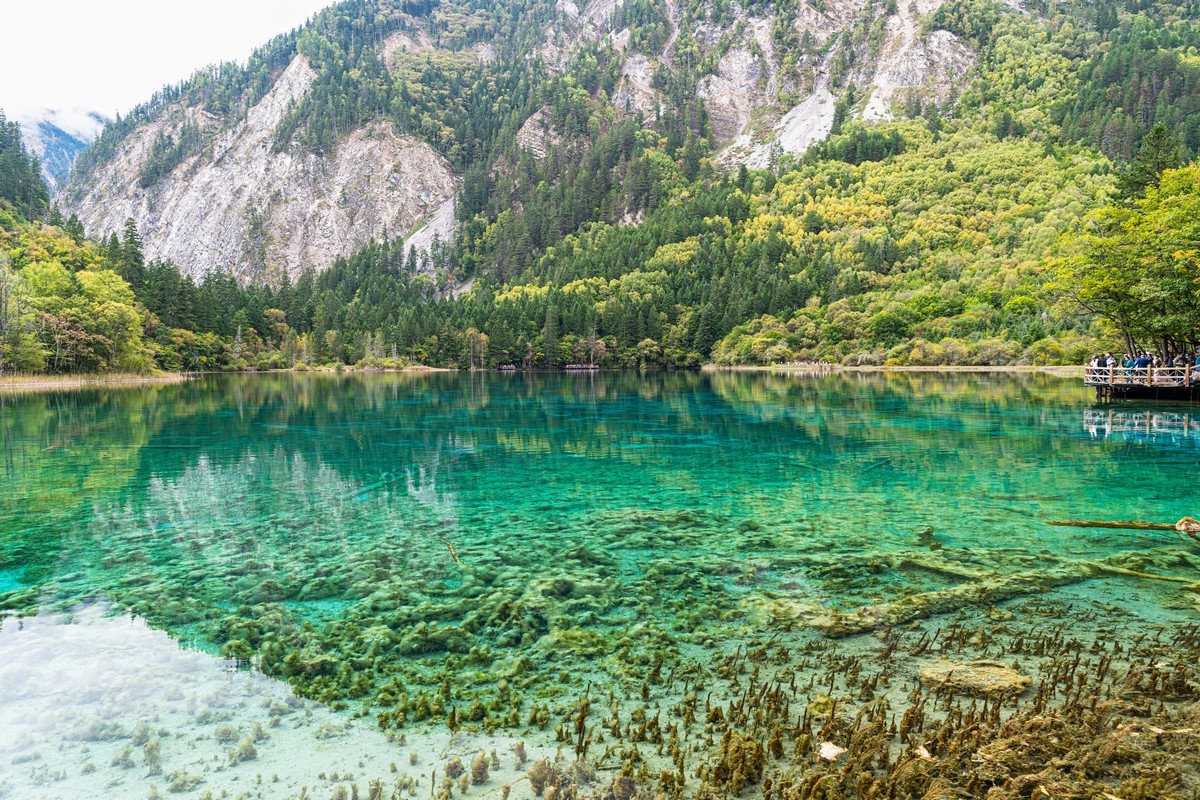
Jiuzhaigou Valley.
Main Highlights: What You Absolutely Can’t Miss
Five Flower Lake (五花海)
Renowned as the crown jewel of Jiuzhaigou, Five Flower Lake captivates visitors with its kaleidoscope of colors. The lake’s unique hues change with the seasons, creating a stunning visual feast year-round. The sparkling waters reveal submerged tree trunks and colorful mineral deposits beneath the surface, providing perfect opportunities for photography from any of its 12 viewing platforms.
Practical Tip: Arrive early in the morning for the best lighting and fewer crowds. The tranquil mornings often yield a mirror-like reflection, making your photos even more enchanting.
Pearl Shoal Waterfall (珍珠滩瀑布)
A magnificent cascade that has earned fame as a filming location for the iconic Chinese series “Journey to the West.” The Pearl Shoal Waterfall features a series of tiered falls that tumble gracefully over a rocky precipice, creating a mesmerizing scene. The sound of rushing water adds to the serenity of this magical place.
Practical Tip: Combine your visit with the nearby Pearl Shoal for a full experience. Bring a raincoat or umbrella, as the mist can soak you, but it’s worth it for the spectacular views!
Mirror Lake (镜湖)
True to its name, Mirror Lake offers breathtaking reflections of the surrounding mountains and forests. This shimmering gem is best visited in the early morning when the water is still and calm, creating a perfect mirror effect.
Practical Tip: Keep an eye out for the weather; visit on a windless day to catch that flawless reflection. If you spot ripple-free water while on the shuttle bus, don’t hesitate to hop off!
Nuorilang Waterfall (诺日朗瀑布)
As the largest waterfall in the park, Nuorilang is a sight to behold. Cascading over 20 meters, it creates a spectacular curtain of water that is best admired from the viewing platforms nearby. The lush surroundings and vibrant colors make this spot idyllic for nature lovers and photographers alike.
Practical Tip: Take the stairs to the lookout point for an elevated view of the waterfall. It’s a bit of a climb, so pace yourself and enjoy the views along the way.
Reed Lake (芦苇海)
A serene turquoise lake surrounded by swaying reeds, Reed Lake is a hidden gem worth the trek. In summer, the lush greenery abounds, while autumn transforms the reeds into shades of gold. This picturesque spot is less frequented by tourists, allowing for a peaceful retreat in nature.
Practical Tip: To reach Reed Lake, walk from Penjing Shoal; it’s a short 10-minute stroll. Bring a picnic to savor while taking in the tranquil scenery.
Long Lake (长海)
As the largest lake in Jiuzhaigou, Long Lake offers stunning vistas that stretch toward the distant snowy mountains. Its crystal-clear waters reflect the surrounding peaks beautifully, especially on sunny days. This is a fantastic spot for leisurely walks along the shore or simply soaking in the atmosphere.
Practical Tip: After visiting Long Lake, consider hiking to Five-Color Lake. The trail is about 1 kilometer and can be steep, but it rewards you with incredible views.
Shuzheng Lakes (树正湖)
The Shuzheng Lakes are a series of interconnected lakes that showcase the vibrant colors of autumn foliage and the refreshing blue of summer waters. This area is perfect for leisurely walks and offers several scenic viewpoints. The lakes are also home to cultural sights like Tibetan prayer flags, adding a spiritual touch to your visit.
Practical Tip: For a panoramic view, climb the stairs near the white pagodas in Shuzheng Village. The climb is steep but worth it for the expansive vistas of the lakes and surrounding forests.
Visiting Jiuzhaigou Valley is like stepping into a vibrant dreamscape, where nature’s beauty unfolds in every direction. Each of these highlights offers a unique glimpse into the valley’s enchanting allure, making it a must-visit destination for every traveler.
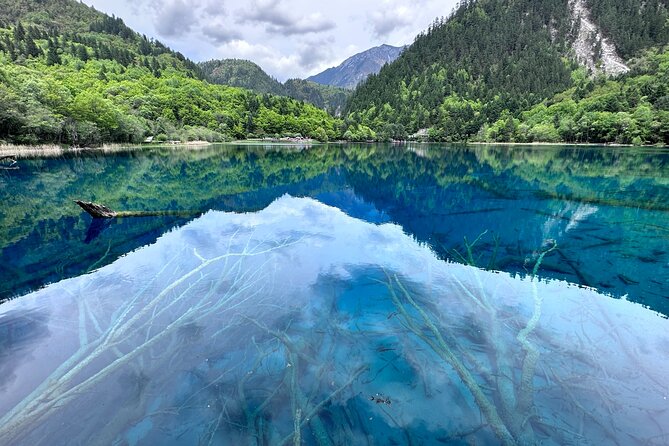
Jiuzhaigou Valley.
Planning Your Visit: A Practical Guide
Best Time to Visit
The ideal time to explore Jiuzhaigou Valley is during the autumn months, specifically from late September to mid-November. During this period, the foliage transforms into a kaleidoscope of colors, creating a stunning backdrop for photographs. If you’re interested in experiencing the valley’s serene beauty without the crowds, consider visiting in the off-peak season from November to March. However, be prepared for some areas to be closed due to winter conditions. Spring (April to June) is also a lovely time, as flowers bloom and the weather is mild.
Recommended Itinerary
One-Day Itinerary:
- Morning:
- Start your day early to make the most of your visit. Take a shuttle bus to Rize Valley first.
- Explore Five Flower Lake and capture its vibrant colors—perfect for photography.
-
Visit Pearl Shoal Waterfall for a quick snap, and then head to Mirror Lake for that iconic reflection shot.
-
Midday:
- Make your way to Shuzheng Valley, where you can admire the Nuorilang Waterfall.
- Spend time at the Shuzheng Lakes, enjoying the colorful forests and Tibetan cultural sights nearby.
-
Stop for lunch at the Nuorilang Restaurant within the park for a quick bite.
-
Afternoon:
- Head to Zechawa Valley to explore Long Lake and Five-Color Lake.
-
If time permits, take a leisurely hike along the trails between the lakes.
-
Evening:
- Return to Nuorilang Center Station and catch the shuttle back to the entrance, soaking in the last views of this magical landscape.
Photography Tips
- Golden Hour: The best lighting for photography is early in the morning or late in the afternoon. This gives your photos a warm glow and enhances the colors of both the lakes and the foliage.
- Tripod: Bring a lightweight tripod to capture long-exposure shots of waterfalls or the mirror-like reflections at Mirror Lake.
- Lenses: A wide-angle lens is ideal for capturing the expansive landscapes, while a telephoto lens can help you zoom in on distant peaks or details in the colorful lakes.
- Patience: Be prepared to wait for the perfect moment. Early mornings often yield the calmest water, perfect for reflection shots.
What to Wear
- Footwear: Comfortable and sturdy hiking shoes are essential, as you’ll be walking on uneven terrain and potentially hiking short trails.
- Layers: The weather can change rapidly, so dressing in layers is advisable. Start with a moisture-wicking base, add an insulating layer, and finish with a waterproof outer layer.
- Accessories: Don’t forget a hat and sunglasses for sun protection, and consider packing a lightweight rain jacket, especially during the wet season.
Insider Tips
-
Timing Your Visit: Aim to arrive at the park gates right when it opens to avoid the crowds. This will help you enjoy the views and take photos without many people in your shots.
-
Shuttle Bus Strategy: Since the park’s shuttle buses operate on a first-come, first-served basis, plan your stops strategically. If you spot a beautiful scene from the bus, consider getting off, even if it’s not a designated stop.
-
Know Your Limits: Be mindful of the altitude, especially in Zechawa Valley, where the elevation can reach over 3,100 meters (10,174 feet). If you start to feel unwell, take breaks and hydrate.
-
Stay Hydrated: Bring plenty of water, as you’ll be exploring for hours. Staying hydrated is crucial, especially at higher elevations.
-
Explore Beyond the Main Trails: If time allows, venture off the beaten path on the hiking trails for a more intimate experience with nature. You might discover hidden gems away from the crowds.
With this practical guide in hand, you are now well-equipped to embark on a memorable journey through the breathtaking landscapes of Jiuzhaigou Valley!
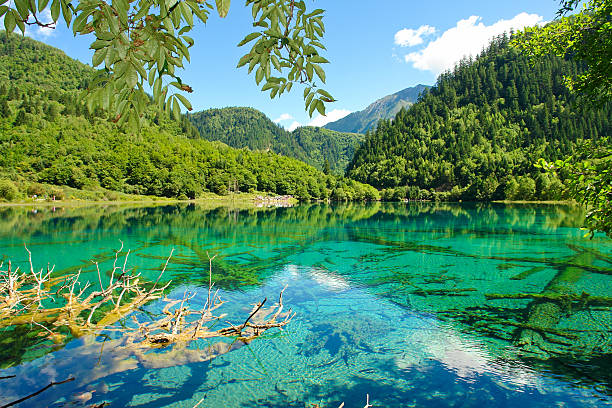
Jiuzhaigou Valley.
Tickets: Prices, Booking, and Tips
When planning your visit to the enchanting Jiuzhaigou Valley, understanding the ticketing options and how to secure your entry is crucial for a smooth experience. Below, you’ll find a comprehensive breakdown of ticket types, pricing, and what each ticket includes.
| Ticket Type | Price (CNY) | Includes |
|---|---|---|
| Single Day Ticket | 300 | Access to the park and shuttle buses for one day |
| Two-Day Ticket | 600 | Access to the park and shuttle buses for two days |
Booking Your Tickets
Tickets for Jiuzhaigou can be purchased either at the entrance or online. However, given the park’s popularity—often welcoming up to 40,000 visitors a day—it’s highly advisable to book in advance to secure your desired date and to avoid long queues at the entrance.
Online Booking
- Official Websites: Check the official Jiuzhaigou tourism website or trusted travel platforms that offer ticketing services.
- Travel Agencies: Many travel agencies provide package deals that include transportation and guided tours, which can simplify your experience.
In-Person Booking
If you prefer to buy tickets on-site, arrive early to ensure you can purchase a ticket for your desired day, especially during peak seasons (spring and autumn) when visitor numbers surge.
Important Tips
- Plan Ahead: Given the unpredictable nature of visitor numbers, securing your tickets well in advance will give you peace of mind.
- Check for Discounts: Various discounts may be available for students, seniors, or group bookings, so inquire about these options at the time of booking.
- Bring Cash: While many places accept credit cards, having cash on hand is essential, especially in rural areas or at small vendors.
By following these guidelines, you can ensure a hassle-free entry into one of China’s most breathtaking natural wonders. Enjoy your adventure in Jiuzhaigou Valley!
How to Get There: A Complete Transportation Guide
From the Nearest Major City
Chengdu to Jiuzhaigou Valley
The most common route to Jiuzhaigou Valley is from Chengdu, the capital of Sichuan Province. Here are your options:
By Air
- Flight Duration: Approximately 1 hour and 15 minutes.
- Airports: Fly from Chengdu Shuangliu International Airport (CTU) to Jiuzhaigou Huanglong Airport (JZH).
- Cost: Flights range from CNY 600 to CNY 1,200 (~$90 to $180) depending on the season and how far in advance you book.
- Notes: Flights can be limited, especially in the low season (November to March), so check availability ahead of time.
By Bus
- Duration: Approximately 9 to 10 hours.
- Cost: Tickets range from CNY 120 to CNY 200 (~$18 to $30).
- Departure Points: Buses depart from various stations in Chengdu, including the Chengdu Xinnanmen Bus Station and Chengdu Shiyangqiao Bus Station.
- Schedule: Buses typically run from early morning until mid-afternoon. It’s advisable to arrive at the station early to secure your ticket.
- Notes: The journey offers beautiful mountain views, but prepare for a long ride.
By Car
- Duration: Approximately 7 to 8 hours.
- Distance: About 330 km (205 miles) from Chengdu to Jiuzhaigou.
- Cost: Rental cars can cost around CNY 300 to CNY 600 per day (~$45 to $90), plus fuel and tolls.
- Route: Take the G213 highway, which is well-maintained but can be winding in certain areas. GPS is recommended for navigation.
- Notes: Having a car gives you more flexibility to explore along the way, including stops at scenic vistas or local villages.
Getting Around the Scenic Area
Once you arrive at Jiuzhaigou Valley, exploring the stunning landscapes is best done via the park’s efficient shuttle bus system.
Shuttle Buses within Jiuzhaigou Valley
- Service: The park has a network of shuttle buses that connect all major scenic spots within the valley.
- Cost: A round-trip ticket costs around CNY 80 (~$12). You will need to purchase this ticket upon entering the park.
- Frequency: Buses run approximately every 10 to 15 minutes during peak times, but this may vary during off-peak seasons.
- Stops: Key stops include Rize Valley, Shuzheng Valley, and Zechawa Valley. Be mindful that not all bus stops allow you to get off, so check the map or ask a guide if unsure.
Walking and Hiking Trails
- Short Walks: Many scenic spots are within walking distance from shuttle bus stops. Expect to do some light walking between key attractions.
- Hiking Routes: For the more adventurous, Jiuzhaigou offers several hiking trails:
- Rize Valley Trail: A 3 km (1.9 miles) trail that takes about 1 hour, leading to breathtaking views of glacial lakes.
- Shuzheng Valley Trail: A less crowded 3 km (1.9 miles) route that can take 1-3 hours, perfect for enjoying tranquil scenery away from the crowds.
Accessibility
- Note on Altitude: Jiuzhaigou Valley is situated at altitudes ranging from 2,000 to 3,100 meters (6,561 to 10,171 feet). Be mindful of potential altitude sickness, especially in higher valleys. Take it slow and stay hydrated.
Tips for Navigating the Park
- Guided Tours: Consider hiring a local guide for a more enriching experience. They can help you navigate the shuttle system, suggest the best places to get off, and share insights about the area’s natural and cultural history.
- Park Map: Grab a park map at the entrance to help plan your day and check bus schedules, ensuring you don’t miss any highlights.
With these transportation options and tips, your adventure to Jiuzhaigou Valley will be seamless, allowing you to focus on soaking up the beauty of this UNESCO World Heritage site!
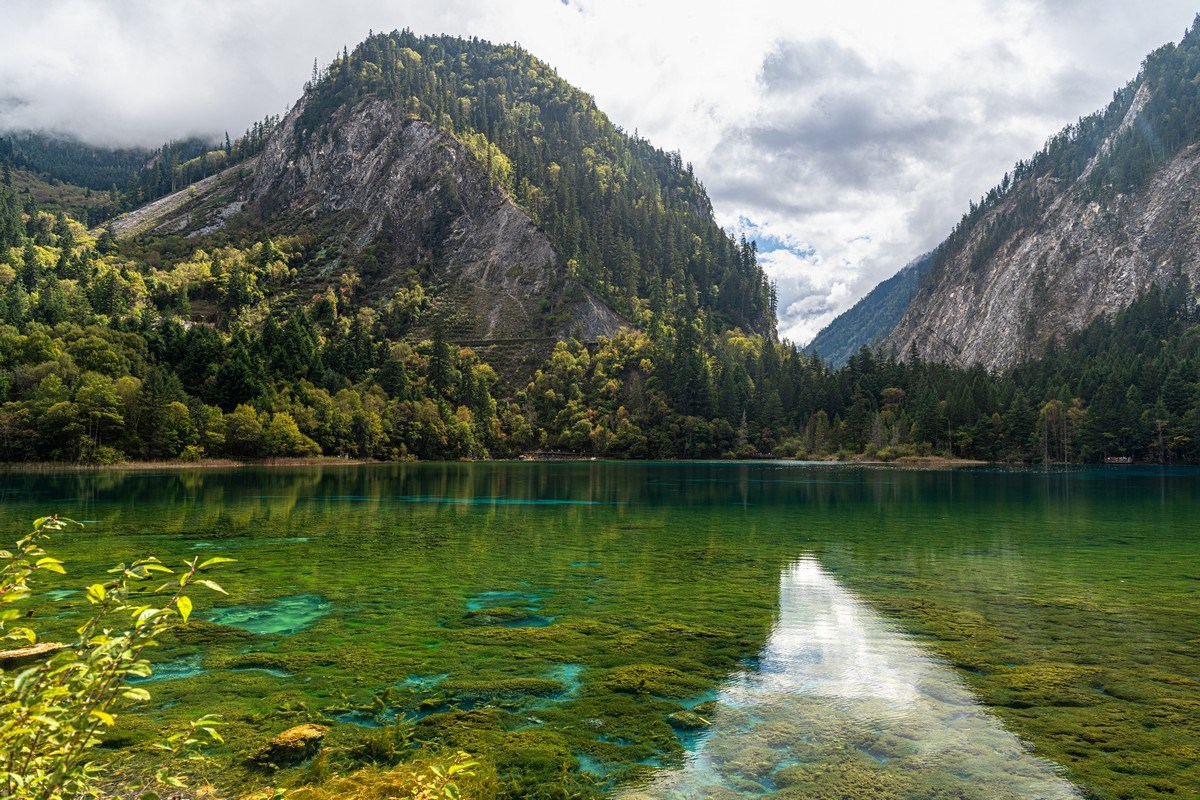
Jiuzhaigou Valley.
Local Cuisine and Accommodation Nearby
Nestled in the breathtaking scenery of Jiuzhaigou Valley, you’ll find a delightful range of local cuisine that perfectly complements your exploration of this UNESCO World Heritage site. After a day of marveling at vibrant lakes and cascading waterfalls, indulging in Sichuan’s culinary delights is an experience not to be missed.
Local Cuisine
-
Tibetan Noodle Soup (Thukpa)
A hearty dish perfect for refueling after a day of hiking, Thukpa is a traditional Tibetan noodle soup that features fresh handmade noodles in a savory broth, often garnished with vegetables, meat, or tofu. The warmth and depth of flavor make it a favorite among travelers seeking comfort food. -
Spicy Hotpot (Huo Guo)
Known for its bold flavors, hotpot is a communal dining experience where diners cook fresh ingredients such as thinly sliced meats, vegetables, and mushrooms in a bubbling pot of spicy broth. This dish is not only delicious but also a fun way to bond with fellow travelers or locals as you share the cooking process. -
Sichuan Mapo Tofu
A classic dish that showcases the region’s famous Sichuan peppercorns, Mapo Tofu consists of soft tofu simmered in a spicy sauce made from fermented black beans, ground pork, and chili oil. Its rich flavors and unique numbing sensation make it a must-try for adventurous eaters. -
Yaks’ Milk Yogurt
For a sweet treat, try the creamy and slightly tangy yak’s milk yogurt, often served with honey or fruit. This dairy product is not only a staple in Tibetan cuisine but also a refreshing way to end your meal.
Accommodation Options
Whether you’re looking for luxury, boutique charm, or budget-friendly stays, Jiuzhaigou offers a variety of accommodations to suit your needs.
-
Luxury: Intercontinental Jiuzhaigou Resort
This opulent resort provides a perfect blend of modern comforts and traditional Tibetan aesthetics. Set against a stunning backdrop, it features spacious rooms, a luxurious spa, and an indoor swimming pool. The resort also offers easy access to Jiuzhaigou Valley, making it an ideal base for exploring the area. -
Boutique: Jiuzhaigou Panda Hotel
A charming boutique hotel that captures the essence of local culture, the Jiuzhaigou Panda Hotel offers a cozy atmosphere with well-decorated rooms. Guests can enjoy beautiful views of the surrounding mountains and a restaurant serving authentic Tibetan and Sichuan cuisine. -
Budget: The Jiuzhai International Youth Hostel
Perfect for backpackers and budget travelers, this hostel offers dormitory-style accommodations as well as private rooms. It’s a friendly place to meet fellow adventurers, and the staff is knowledgeable about the area, providing helpful tips for your excursions.
With an array of mouthwatering dishes and accommodation options to suit all budgets, your visit to Jiuzhaigou Valley promises to be as enriching for your palate as it is for your spirit. Enjoy the vibrant local culture and the stunning natural beauty that this remarkable destination has to offer!
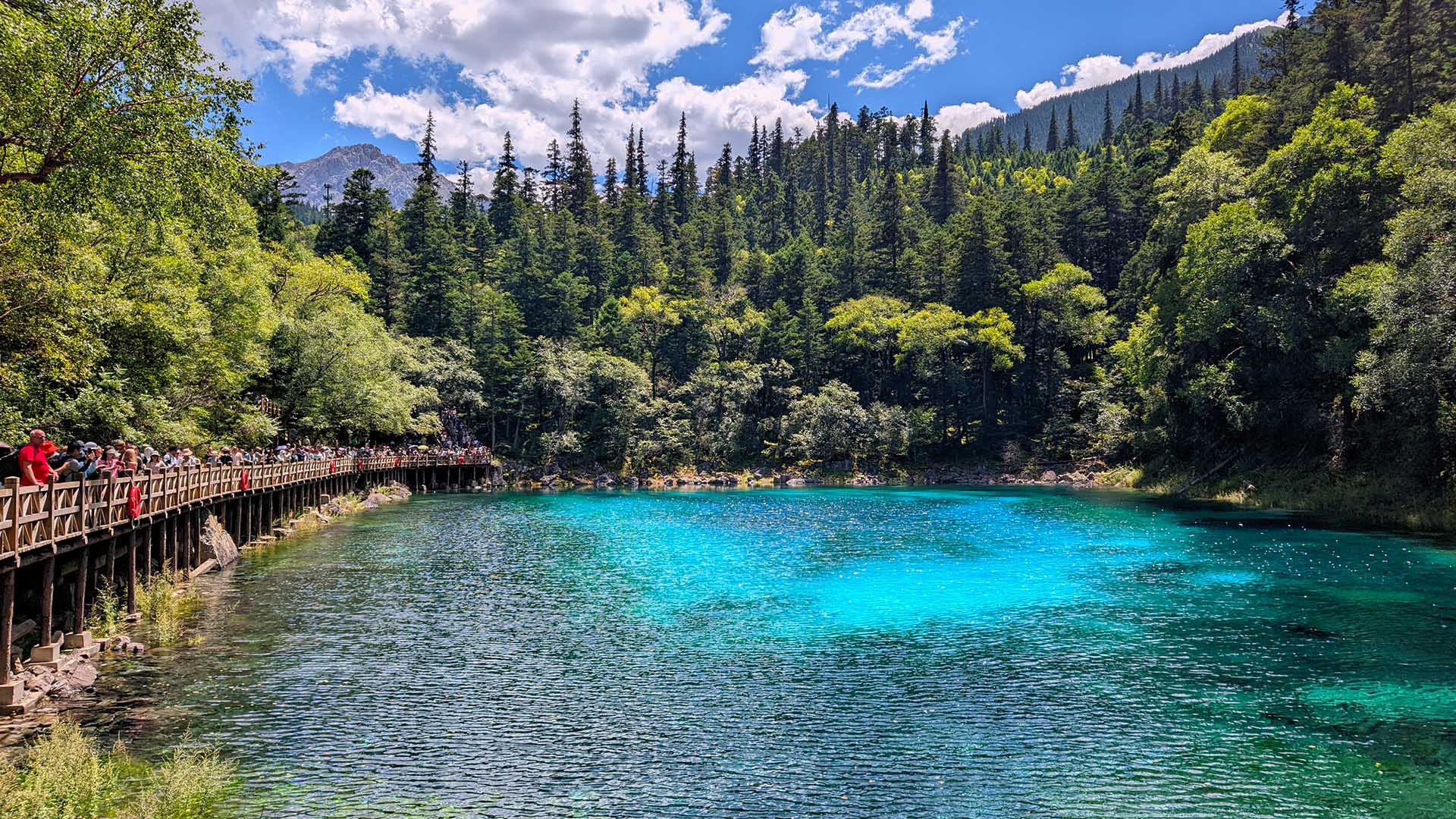
Jiuzhaigou Valley.
Frequently Asked Questions
Frequently Asked Questions about Jiuzhaigou Valley
1. Is Jiuzhaigou Valley suitable for children and the elderly?
Yes, Jiuzhaigou Valley is generally suitable for children and elderly visitors. The park offers well-maintained pathways and shuttle buses that connect the major scenic spots, making it accessible for those with limited mobility. However, some areas may involve stairs or steeper paths, so it’s advisable to assess individual fitness levels before visiting.
2. Are there English signs and guides available in Jiuzhaigou?
While Jiuzhaigou Valley primarily caters to Mandarin-speaking visitors, there are English signs at major points of interest. Additionally, hiring an English-speaking guide can significantly enhance your experience by providing insights into the park’s natural beauty and cultural significance.
3. How much time should I plan for a visit to Jiuzhaigou?
A day trip is typically sufficient to see the main highlights of Jiuzhaigou Valley, especially if you use the shuttle buses to navigate the park. However, if you wish to explore more thoroughly or hike some of the trails, consider spending two days to fully appreciate the stunning scenery and avoid feeling rushed.
4. What is the best time to visit Jiuzhaigou?
The ideal time to visit Jiuzhaigou is during the fall (September to November) when the foliage turns vibrant colors, creating a picturesque landscape. Spring (April to June) is also beautiful, featuring blooming flowers and lush greenery. Summer can be crowded, while winter offers a unique, snowy charm but may limit access to certain areas.
5. How do I get to Jiuzhaigou Valley from Chengdu?
The most convenient way to reach Jiuzhaigou is by taking a direct flight from Chengdu to Jiuzhaigou Huanglong Airport (JZH), which is about an hour from the park entrance. Alternatively, you can take an overnight bus or arrange a private transfer, though these options take significantly longer.
6. Will I experience altitude sickness in Jiuzhaigou?
Jiuzhaigou is located at altitudes between 2000 to 2500 meters (6,561 to 8,202 feet), which can cause mild altitude sickness in some visitors. To minimize discomfort, stay hydrated, avoid strenuous activities, and allow time for acclimatization, especially if you are coming from lower elevations.
7. Are there dining options inside the park?
Yes, there is a restaurant located at Nuorilang Center Station, offering a variety of meals, snacks, and drinks. While it may not provide gourmet options, it is a convenient spot to refuel during your visit. Consider packing snacks or a picnic if you prefer more variety.
8. Can I bring my own food and drinks into Jiuzhaigou Valley?
Yes, visitors are allowed to bring their own food and drinks into Jiuzhaigou Valley. However, be mindful of the park’s regulations regarding littering and dispose of waste properly to help preserve the natural beauty of the area.
Final Thoughts on Your Trip
As your adventure in Jiuzhaigou Valley comes to a close, take a moment to reflect on the breathtaking beauty that surrounds you. From the shimmering reflections on Mirror Lake to the vibrant hues of Five Flower Lake, every corner of this UNESCO World Heritage site offers a unique glimpse into nature’s artistry. The cascading waterfalls and lush forests invite you to breathe deeply, reminding you of the tranquility found in untouched landscapes.
Whether you ventured through the captivating Rize and Shuzheng valleys or took in the panoramic views from Zechawa, each experience is a cherished memory waiting to be recounted. As you leave Jiuzhaigou, carry with you not just photographs but the essence of a place where nature thrives in its most vivid form.
Embrace the spirit of adventure and let Jiuzhaigou inspire your future travels. There are countless wonders waiting to be explored, and every journey begins with a single step. Safe travels, and may your next destination be as enchanting as the last!